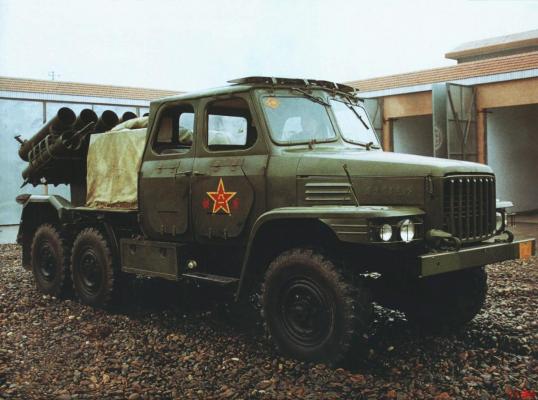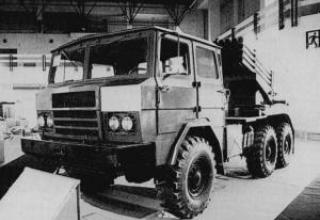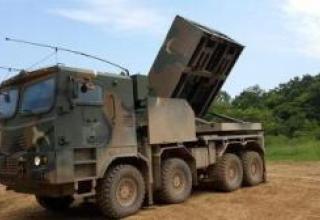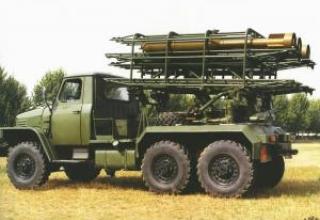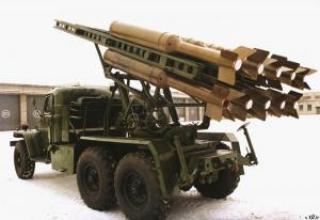The Type 81 combat vehicle is designed for remote mine clearance of anti-personnel minefields.
The Type 81 BM was developed by NORINCO, China's state defence corporation. It was and still is in service with the People's Liberation Army of China. There are 142 combat vehicles assembled. No information on export deliveries.
Artillery unit of the combat vehicle is mounted on the modified chassis of the cross-country vehicle (wheel formula 6×6) with an extended four-door fully protected cab. It consists of a package of 10 tubular guides: two rows of five pipes each (see photo_1, photo_2).
When deployed in a firing position, the cabin sight-glasses are closed with hinged safety panels located on the roof of the cabin and on the sides of the doors. The spare wheel is positioned horizontally at the rear of the cab .
Type 81 Type 81 253mm unguided rockets are used for firing (see photo). A special feature of the NURS is the presence of a special headstock, which ensures that the ammunition will explode in the air and, as a result, increase its effectiveness for the intended purpose. The maximum range of the projectile is 1400m. The time of full salvo - 12 - 14s.
The latest version of the NURS from the BM ammunition set, designated Type 81-II, has a maximum range of 2000m (according to other data up to 3000m).
Composition:
The K-37 missile is designed according to the normal aerodynamic scheme with a small wing of elongation (see the scheme). Stabilizers are in a folded position before launch. The guidance system is inertial, with radiocorrection and active radar homing on the final section of the flight path.
Four K-37M are suspended in two pairs one after another under the fuselage of the MiG-31BM. At launch, the rocket first with the help of catapult installation AKU-410-1 is thrown down from the aircraft, and then starts a dual-mode solid propellant engine.
The missile K-37 (product 610) was equipped with a radar homing head GSN 9B-1388 / MFBU-610/. 9B-1388 was developed by Research Institute "Agat" and serially produced by Ryazan radio plant. The diameter of SL 9B-1388 is 380 mm, weight - 40 kg, range of radiocorrection (from the carrier) - up to 100 km, range of target acquisition with the area of 5m2 active radar SL 9B-1388 - 40 km.
The K37M missile (RVV-BD, product 610M) is equipped with a new advanced active radar SLN 9B-1103M-350 developed by JSC Research Institute "Agat" (see description).
GSN 9B-1103M-350 provides:
- searching, capturing and escorting air targets,
- receiving and decoding radiocorrection signals,
- formation and transmission of signals over a digital communication line to control the missile.
Mode of operation :
- Fully autonomous (active) mode by pre-targeting without radar support in flight (the "let-forget" mode),
- radio-corrected inertial guidance mode,
- reprogramming mode.
According to the published materials, the maximum launch range of the airborne airborne radar escort sample into the PPS for some types of targets is 200 km.
The combat unit is a shrapnel-flagged one. Explosive device - radar active non-contact and contact target sensors. The missile is equipped with a dual-mode solid propellant engine.
The RVV-BD, compared to the K-37, has a shortened head compartment with a radio-transparent fairing of a new shape. The length of the RVV-BD is 140 mm shorter than that of the K-37.
Suspension of the RVV-BD missile on the carrier, power supply in flight, tactical launch and emergency reset is carried out using an aircraft catapult device AKU-410-1 (AKU-620). When placed on a carrier, unlike the K-37, only the upper stabilizer rudders are added to the RVV-BD.
The designated service life is 8 years. The designated service life of the missile is 50 flight hours with an unlimited number of takeoffs and landings with concrete coating (20 takeoffs and landings with ground and metal coating). Continuous operation time of the equipment in flight under the carrier aircraft - 3 hours. Serviceability of onboard equipment of the rocket at operation is checked annually on a complex of preparation of aircraft destruction means "Oka-E" or on control equipment "Oka-620".
The Airborne Breakout System includes the following types of training and training missiles:
- RVV-BD-UD is a training and operational missile for ground training of technical personnel in rules of preparing missiles for use, storage, transportation and operation;
- RVD-BD-UL is a training and flight missile for training flight personnel in operations involving the combat use of missiles without actual launches;
- RVV-BD-UL - a training and cutting missile to study the flight and technical composition of the missile system;
- RVV-BD-GM - a dimensional model of the rocket to assess the TTH of the aircraft carrier with missiles on a suspension.
Characteristics:
| BM Specifications | |
| Dimensions in camping position, m: length width altitude |
6800 2200 2450 |
| Weight of equipped BM, kg | 8300 |
| Weight of unloaded combat vehicle, kg | 6954 |
| Maximum travel speed, km/h | 40 |
| The depth of the ford to be overcome, mm | 850 |
| Ammunition, pcs. | 20 |
| Number of tubular rails, pcs. | 10 |
| Salvo time, s | 12–14 |
| Angle of elevation, hail: minimum maximum |
+20 +50 |
| Angle of horizontal fire, deg | 135 |
| NURSE Specifications Type 81 | |
| Caliber, mm | 253 |
| Guide rail speed, m/sec. | 24 |
| Maximum projectile range, m | 1400 |
| NURSE Specifications Type 81-II | |
| Caliber, mm | 253 |
| Weight, kg | 74,5 |
| Maximum projectile range, m | 2000 (3000) |
Testing:
From September 1 to November 28, 1945, the Nb.W.42 trophy mortar was tested at the Red Army State Automobile and Space Administration. The tests were carried out on the basis of the order of the Deputy Chief of SAKP, Major-General of the Engineering and Artillery Service of Serebryakov under the program of the range - SAKP task №4410.
In the report No 0116 dated 19.1.46 the description of the device and operation of the Wgr.42 mine, L.J.gr.Z23nA fuse and the mortar were given. Data on the heap and range, as well as theoretical calculations of internal and external ballistics are given. In addition, the report contains the results of analysis of the hull materials and equipment. The test manager was Captain Lerner.
The purpose of the tests was to determine:
- basic characteristics of the mortar and the mine Wgr.42 /description of the device, operation and purpose/.
- Intraballistic characteristics Wgr.42 /powder gas pressure and charge burn time/.
- aerodynamic characteristics Wgr.42 (wind tunnel blowing).
- The impact and maximum mine speed and the nature of mine buildup in the active area.
- Maximum range at 10°, 20°, 30° and 45° elevation angles.
- The mine's blast and fragmentation effect on the target.
- the system's strength, stability and rate of fire.
When measuring five minutes on centering belts, the projectile caliber was 214 mm, so the report suggested "counting the caliber not 210 mm as usual, but 214 mm".
The conclusions of report No. 0116 were as follows:
- The 210 mm Wgr.42 rocket projectile with the M-13UK missile was characterized by simplicity, cheapness and availability of materials that were used for its production. It was noted that the Germans considered it possible for missile chambers to allow deformation at maximum pressure beyond the elastic limits, i.e. the chambers were calculated not on the elastic limit, but on the temporary resistance to rupture with a margin of strength of the order n=1.5.
- Manufacturing of dinitroglycol powders for rocket charges had advantage in comparison with manufacturing of nitroglycerine powders. As glycol was based on cheap raw material base (vegetable oils), and glycerin was mainly produced from animal fats.
During the study of the mine, it was disassembled into structural elements. See their photos: photo 1, photo 2, photo 3, photo 4, photo 5, photo 6, photo 7.
From August 8th till August 13th 1945 at the State Mine Stockpile of Ukraine there were conducted shooting to determine experimental data for drawing up tables of shooting. Shots were fired at an elevation angle of 10°, 20°, 30° and 45° (maximum possible elevation angle).
The mortar was simultaneously loaded with 5 shells. The mortar was fired in single shots. The charge was corrected after each shot, and the shoot down rate was insignificant. Due to lack of German mortar sight, side aiming was made with MP-41 sight.
As a result of tests it was received:
- The puchiness and range of the 210 mm Wgr.42 missile did not differ from the characteristics of the domestic M-13UK projectile. When the angle of Ө decreases (elevation angle) the heap drops sharply especially in range: gri Ө=10° the range of 2650m and the WDX = 1/17 was obtained; WDX = 1/58, at Ө=45° the range of 8000 m and the WDX = 1/88; WDX = 1/76.
- The effect of the Wgr.42 mine on the target was undoubtedly more powerful than that of the M-13UK, as the 210mm projectile carried 9.27 kg of explosives, while the M-13UK carried 4.55 kg. However, the Wgr.42 has a smaller fill factor /WB to passive weight ratio than the M-13UK. The M-13UK had a filling ratio of 13% and Wgr.42 had a filling ratio of 10%.
- The design of the Wgr.42 mine was characterized by the simplicity, affordability and accessibility of the materials used in its manufacture.
- Calculation of internal ballistics showed the following results: at charge temperature - 40°C the pressure in the chamber was equal to 106 kg/cm2, at charge temperature +40°C the pressure was equal to 325 kg/cm2. This gave grounds to suppose that the rocket charge will work at low temperatures and will not break the chamber at high ones.
- The chemical composition and physical characteristics of the gunpowder rocket charge did not differ from glycol powders, which were adopted in German artillery. Powder strength and caloric value were of the same order as M-13UK rocket charges, but the use of glycol undoubtedly extended the raw material base of the powder production.
- The design of the 210-mm 5-barrel Nb.W.42 mortar carriage did not differ from that of the 150-mm 6-barrel Nb.W.41 mortar carriage.
- The maneuverability and ease of operation are satisfactory, but the power of the 210 mm mortar salvo is about 1.5 times smaller than that of the BM-13. For one salvo of 5-barrel mortar ejected 46 kg ВВ, and installation BM-13 - 73 kg ВВ.
It was concluded that the design of the 210 mm Nb.W.42 rocket launcher and its projectile was found to be successful, both in combat and operational terms.
The mortar was disassembled into its structural elements during its study. See their photographs: photo 1, photo 2, photo 3, photo 4, photo 5, photo 6, photo 7, photo 8.
Sources:
- Forecast International. – August 2001.
- Jane’s Armour and Artillery 2000-2001. – P. 763.
- Jane’s Ammunition Handbook 2000-2001. – P. 630.
- http: //www.bemil.chosun.com.
